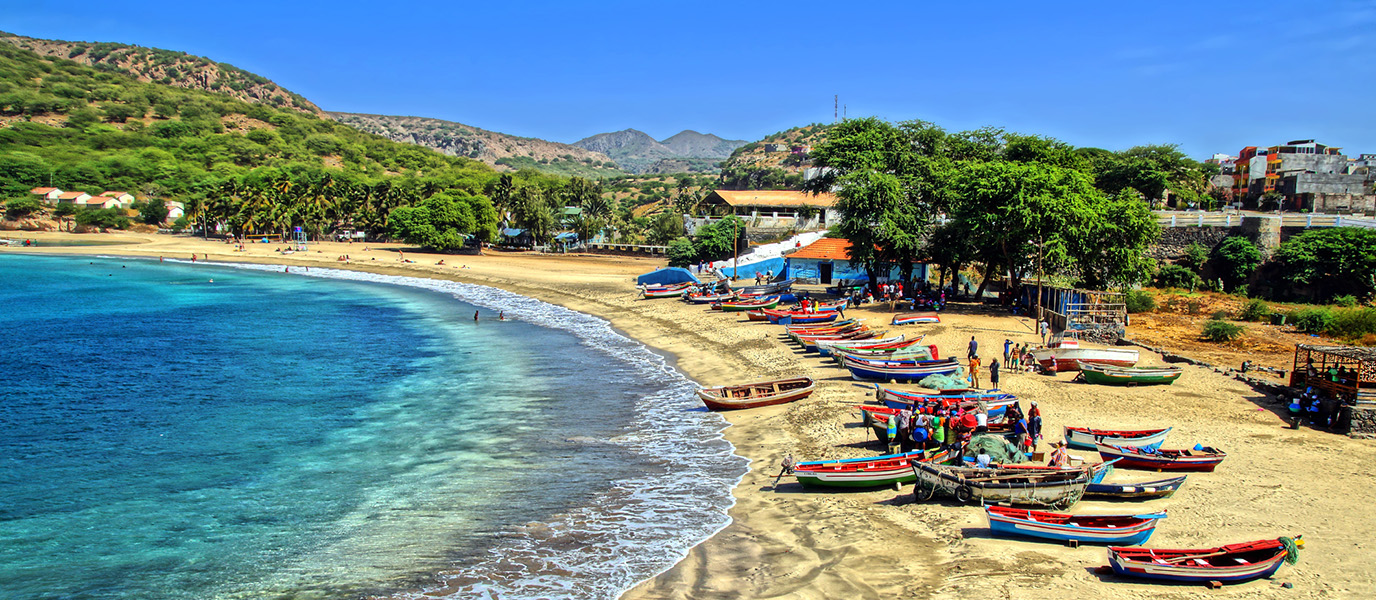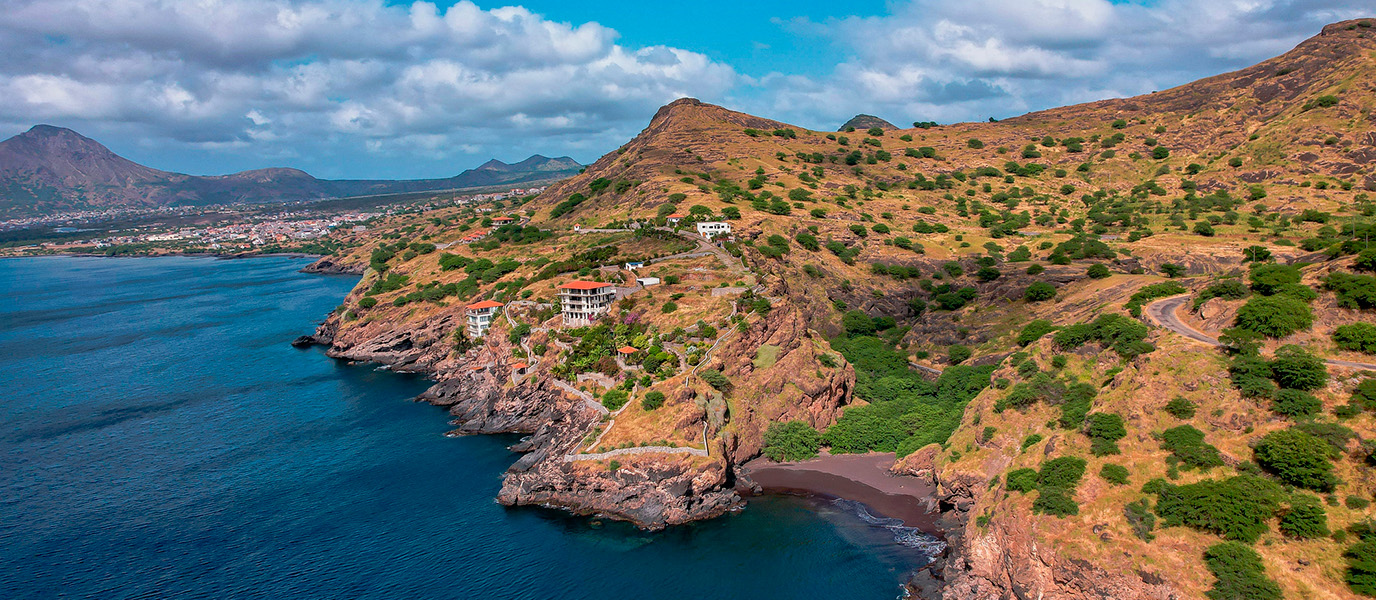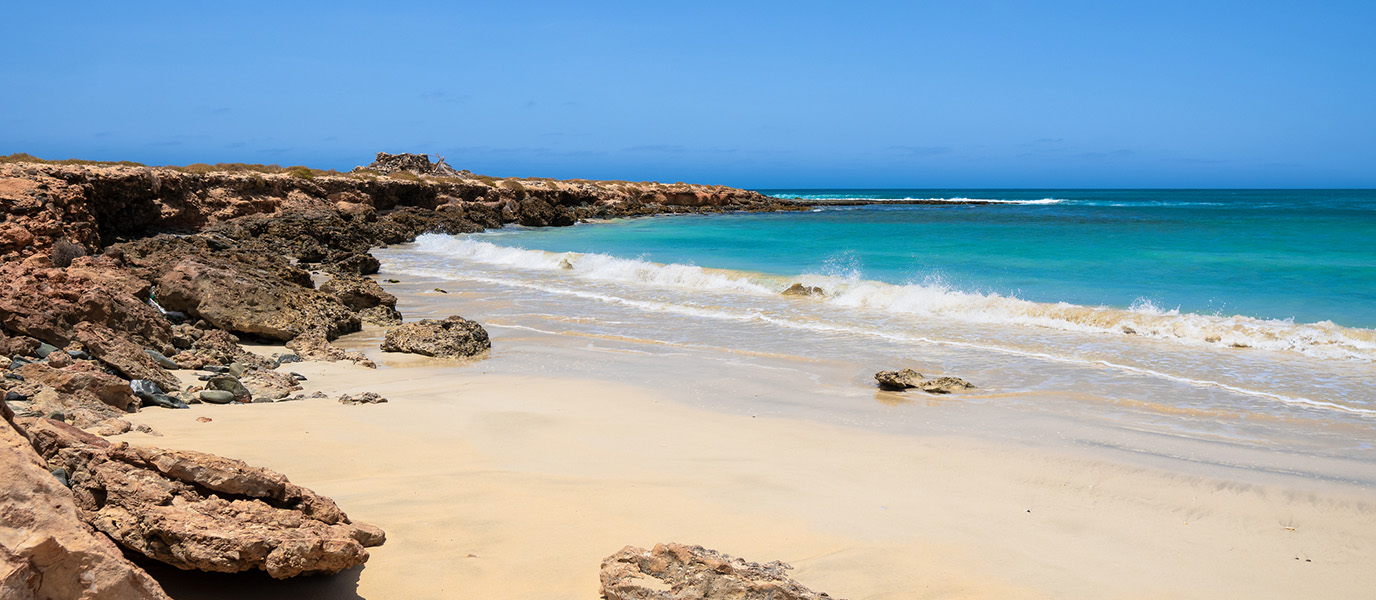The island of Santiago is the beating heart of Cape Verde: one of the ten islands that make up the archipelago, and the one that brings together in one place all the elements of the Cape Verde spirit, offering the visitor a panoramic perspective of the country’s character. As the largest island (and the first to be colonised by the Portuguese in 1462), Santiago offers a rich diversity of scenery and experiences that attract all types of travellers. From the buzzing streets of the capital, Praia, to Cidade Velha, the first city founded by the Europeans in western Africa, to the virgin beaches of Tarrafal, the authentic character of this island casts a spell over every visitor. But Santiago is more than just a beach-lover’s paradise: it is also a land of mountains, lush rural valleys, and towns where African traditions remain strong. Are you ready to discover them?
The natural and historical context: an Atlantic crossroads
Santiago is an island characterised by geographical diversity and a profound sense of colonial history. The first Portuguese explorers reached Santiago’s coasts in 1462, and soon established Cidade Velha, the first European city in western Africa, which rapidly developed into a key port in the slave trade. This city reflects the brutality of colonialism, but also the fusion of cultures that defines Cape Verde today. In 2009, it was declared a World Heritage Site by UNESCO, thanks to its historical importance and its wealth of colonial monuments. The fortifications and monuments that survive in Cidade Velha are a testament to a time of upheaval, when Santiago was a key point on transatlantic routes.
In addition to its great historical value, the island also has an impressive natural environment. Its geography is dominated by the Serra Malagueta, a mountain range that rises northwards from the centre of the island, and is home to one of the country’s most important natural parks. Santiago’s landscapes are unique: from its golden beaches and steep cliffs to its fertile valleys with tropical plantations where sugar cane, bananas and mangos are grown. It is in these areas that little towns retain their ancestral traditions, and travellers can appreciate the true character of life in Cape Verde.
The Serra Malagueta, boasting peaks that rise to a height of 1,064 metres, not only offers panoramic views over the island, but also protects its rich biodiversity. Visitors can see endemic plant species and diverse wildlife, including small reptiles and native birds. In addition, Santiago has an extensive coastline with some of the quietest and least-known beaches in the archipelago.
Cities to visit on the island: between Cape Verde’s two capital cities
Praia, with its colonial past and Creole present in the lively capital of Cape Verde
Praia, the capital of Cape Verde, is the financial and administrative centre of the country. It is a buzzing city, full of energy and life, which straddles the legacy of its opulent but cruel colonial past and its modern, vibrant, African, Creole present.
In the city’s historical quarter, known as Plateau, which stands on a promontory with views of the Atlantic Ocean, colonial buildings such as the Presidential Palace, Praça Alexandre Albuquerque and the cobbled streets lined with brightly coloured houses recall the city’s colonial past. The historic quarter’s greatest attractions include the Church of Nossa Senhora da Graça, built in a neo-Classical style in the nineteenth century, and the Ethnographic Museum, which offers a fascinating perspective on the history of the islands and their Creole culture. Nor should visitors miss the Monument of Diogo Gomes, the Portuguese sailor who discovered the island of Santiago in 1460.
If you want to see the other side of the city, don’t miss enormous, bustling, Sucupira Market, which sells everything from local foods to crafts, reflecting the nature of daily life on Santiago. And if you fancy a dip, Praia has several urban beaches, the finest being the popular Praia de Gamboa, which in May every year celebrates the Festival of Gamboa, one of the country’s principal musical events.
In addition, Praia is an excellent point of departure for exploring other parts of the island, as it has good transport connections and a great range of restaurants and accommodation.
Cidade Velha, the legacy of the first capital of Cape Verde
From a historical point of view, Cidade Velha is, without a doubt, the most important place on the island of Santiago, as it is both the first European city to be established in the tropics, and a UNESCO World Heritage Site. This former capital, founded in 1462, is a living testament to the first phase of colonisation by the Portuguese.
Here you can visit the Royal Fortress of São Filipe, built in the sixteenth century to repel incursions by English pirates such as Francia Drake. The fortress offers spectacular views of the coast and of the small city. Take a stroll along Rua Banana, the oldest urban street in Cape Verde (some say the oldest in the whole of Africa), with its traditional stone houses. And don’t miss the Church of Nossa Senhora do Rosário; built in 1495, it is the oldest colonial church in the world and one of the oldest churches on the entire continent. You can also visit the nearby ruins of Sé Cathedral which, in the sixteenth century, was the biggest religious edifice, not only in Cape Verde but also along the whole coast of Africa, until it was destroyed in 1712 during a great sacking by the French.
And the chilling Pelourinho, a stone column in the centre of the main square where rebel slaves were publicly punished — a sombre reminder of the history of the colonial era’s slave trade. Visiting Cidade Velha is like journeying back in time to the early days of colonisation in the Atlantic.
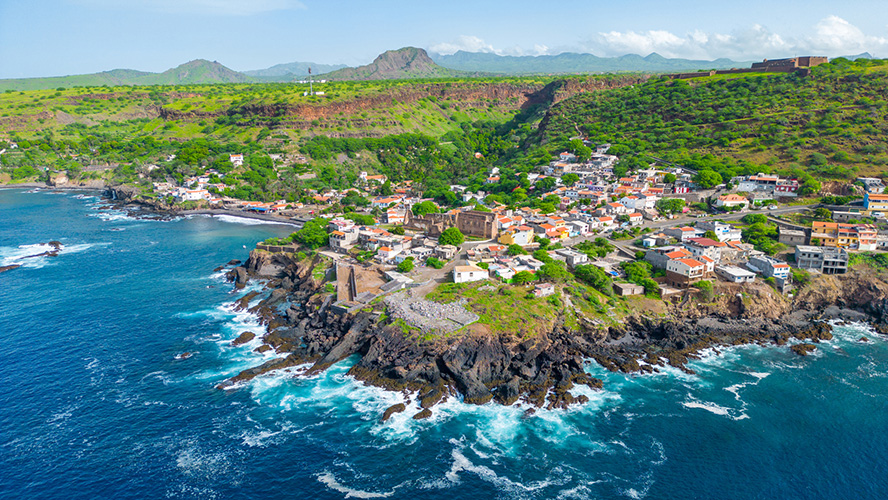
Tarrafal, an idyllic refuge with a dark past
Tarrafal, in the north of Santiago, is the perfect destination for those looking to relax in a paradisical setting. Famous for its beach of white sand — the only one on the island — and its crystal-clear waters, Tarrafal offers an idyllic sanctuary after the bustle of Praia, and is, in fact, the capital’s favourite place for weekend breaks. An hour-and-a-half drive from Praia, it has a recently built seafront promenade and its sheltered bay is perfect for swimming, diving and other water sports.
In addition, the area is infamous for its history, as it was the site of a former concentration camp used during the Salazar dictatorship in Portugal, the Campo de Concentração do Tarrafal, now a museum dedicated to the memory of the political prisoners. Known as the “Camp of the Slow Death”, this camp was in operation between 1936 and 1954 as a prison for Portuguese political prisoners. Later, between 1962 and 1974 under the name of Campo de Trabalho de Chão Bom, it was a penitentiary for nationalists from Angola, Guinea-Bissau and Cape Verde. It has been calculated that 10% of the prisoners died as a result of the terrible, unhealthy conditions under which they were detained.
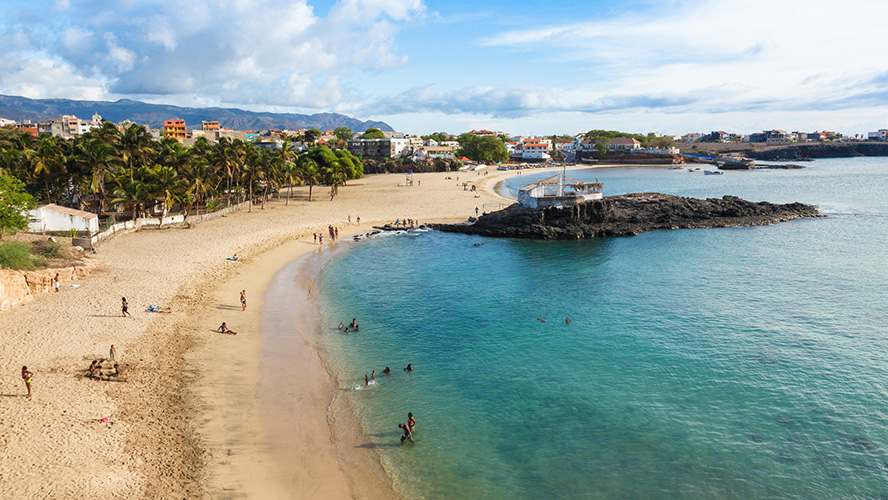
Hiking and nature: The country is called Cape Verde for a reason
If you love hiking and nature, you will be impressed by Santiago’s varied, green scenery and its challenging trails.
The Serra Malagueta Natural Park, in the north of the island, is a paradise for hiking enthusiasts. This mountain range affords impressive views and a rich natural biodiversity with endemic species of both flora and fauna, some of which are in danger of extinction, such as vultures, the Bourne heron, and the Cape Verde warbler. There is a good variety of hiking trails, ranging from easy routes to more challenging climbs to peaks such as the Pico da Antónia, the island’s highest peak which rises to 1,064 metres.
Another essential visit is to the Vale de Ribeira Grande, where you will find traditional little towns such as Salineiro and Calabaceira, set among green agricultural fields. Walking through this valley will allow you to immerse yourself in the authentic rural life of Santiago, and to enjoy the genuine hospitality, which the locals sum up with the word ‘morabeza’.
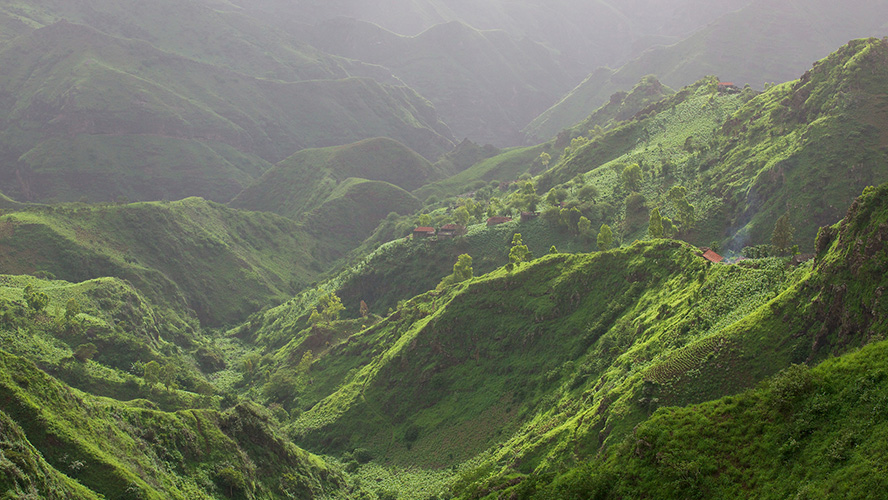
The best beaches: sun and sea in a wild, idyllic setting
Santiago is famous for its picturesque beaches, which offer visitors a calming, relaxed experience. Tarrafal beach is the most famous, as it is the only beach on the island with white sand; it also has turquoise waters, perfect for swimming or soaking up the sun.
Other less well-known but equally beautiful beaches are São Francisco and Calheta de São Miguel, in the north-east of the island. Both are ideal for anyone looking for peace away from the crowds.
As well as sunbathing, Santiago’s beaches also offer the chance to enjoy water sports such as surfing, windsurfing and diving, with an abundance of marine life and reefs to discover.
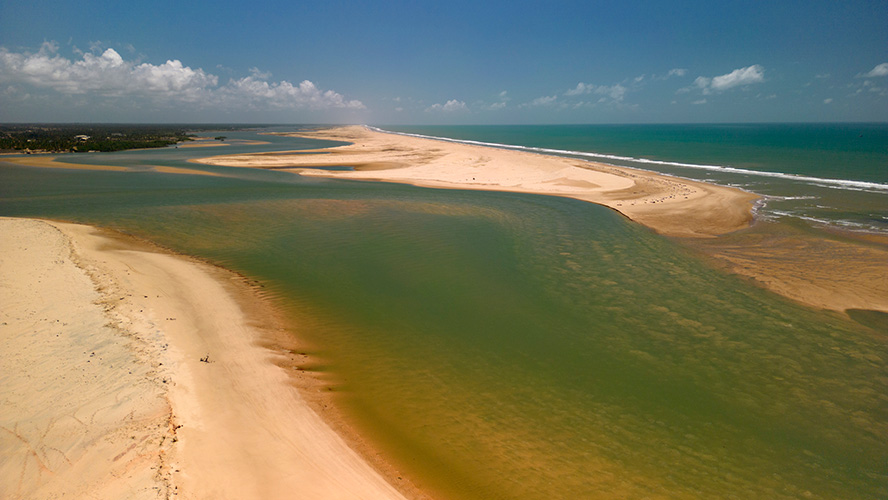
Activities not to be missed: drinking grogue to the sound of morna
Cape Verde, and particularly the island of Santiago, offers a great deal of outdoor activities and cultural experiences. Apart from hiking and water sports, the island is known for its vibrant music scene. Don’t miss the opportunity to attend a concert of traditional Cape Verde music, such as morna or funaná, in Praia’s bars.
You can also explore the sugar cane plantations, and try ‘grogue’, the local liquor distilled from sugar cane, in the small distilleries scattered around the island. For more adventurous travellers, diving and snorkelling offer the chance to explore the rich marine ecosystems, with reefs teeming with life and warm waters that will tempt you to venture in.
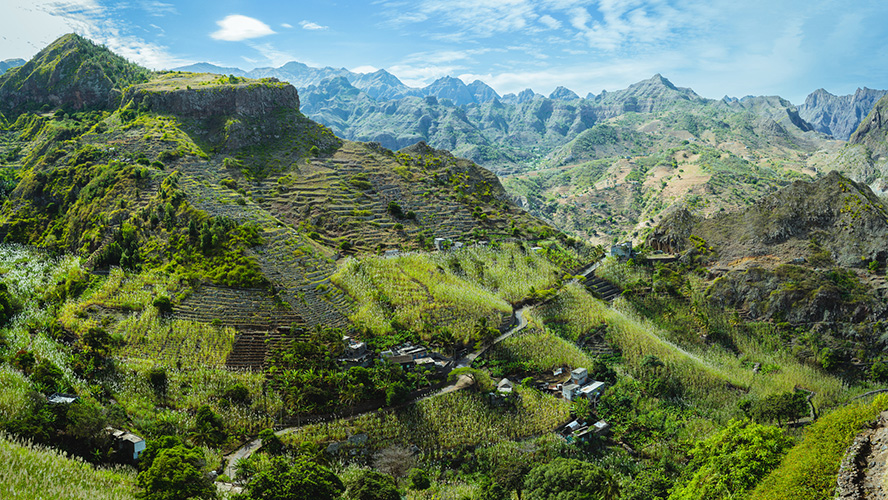
Tips on how to get around the island: shared minivans or ‘aluguers’, the most local form of transport
Getting around the island of Santiago is relatively easy, thanks to its network of surfaced roads and public transport services. Minivans, known as ‘aluguers’, are the most common form of transport between towns and cities. For greater freedom in travelling around, you could also hire a car, especially if you are planning to explore the more remote, rural areas.
If you are visiting Praia, it is easy to get around on foot or by taxi. If you want to visit places such as Cidade Velha, Serra Malagueta or Tarrafal, public transport or organised tours are good options, as they will allow you to enjoy a stress-free experience.





























































